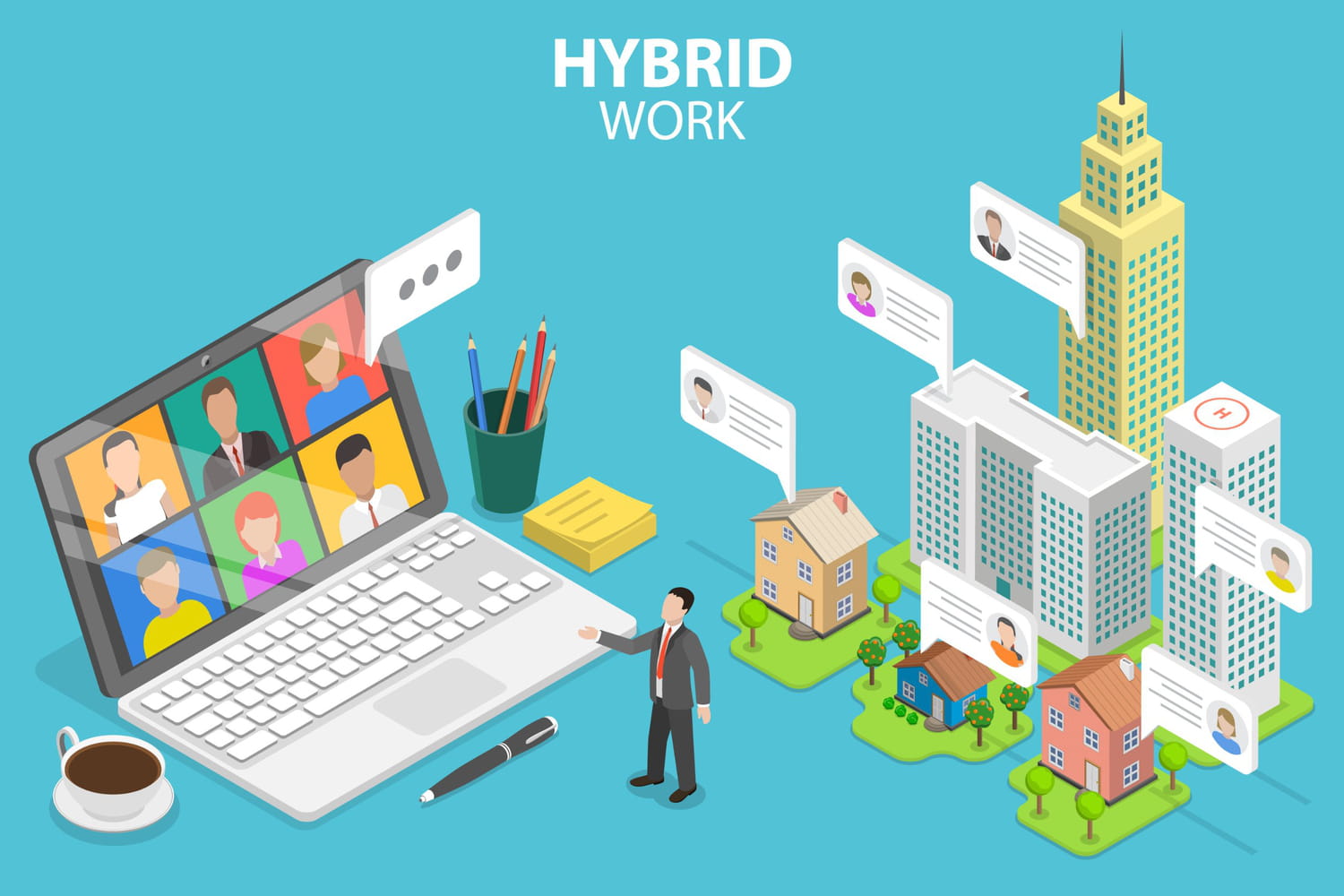
With hybrid work, companies equip themselves with tools to ensure business continuity. From the videoconferencing application to the virtual management platform, these are the key building blocks of a hybrid workplace.
The health crisis has radically changed the organization of work. With the generalization of teleworking, a company today must guarantee the continuity of activities with geographically dispersed employees who work with heterogeneous tools. This digital workplace is now getting a name. The hybrid workplace, as a growing number of vendors call it, aims to provide a unified experience for employees by combining the best of face-to-face learning and distance learning.
In the 2022 edition of its “State of the art of the internal transformation of organizations”, the French company Lecko lists the main constituent elements of this hybrid work environment. It all starts with the joint publication of documents online. The concept, popularized by the Microsoft 365 and Google Workspace collaboration suites, is nothing new, but is becoming essential in a hybrid-mode organization.
Prioritize united cooperation
On-site or remotely, employees work on the same document providing real-time feedback and suggested changes. Screen sharing allows you to present your content to all participants in an online session. A new generation of so-called visual management platforms including Miro, Mural, Stormboard or the French iObeyan and Klaxoon. In these persistent environments, people who are absent from a meeting can catch up. In these solutions we also find specific practices for agility, such as notice boards in Kanban mode and walls with virtual labels that move to indicate the progress of a project.
For Bastien Le Lann, associate director of Lecko, “the organization of work in hybrid mode should be inspired precisely by the foundations of agile methods, first and foremost the definition of results-oriented objectives, the transparency of exchanges and the celebration of the results achieved”. For example, a project management tool like Trello makes the tasks that need to be performed by each team member transparent.
Towards inclusive tools
A little soon forgotten, social business networks (Jalios, Jamespot, eXo Platform, Talkspirit, etc.) are experiencing a renewed interest in a post-Covid world by disseminating information and celebrating successes. These CSRs have also developed features to promote informal exchanges, such as Powell’s Virtual Coffee Machine, Wimi’s Stories, or Jamespot’s collaborative 2D metaverse.
The pandemic underlined the importance of integrating so-called frontline workers through digital channels. Sociabble, Steeple or even Meta’s Workplace provide platforms for these frontline workers. “This makes it possible to reconcile knowledge workers and frontline workers,” says Bastien Le Lann. “For lack of something better, historically the former have mainly used e-mail and the latter WhatsApp”.
“It is necessary to reorganize the information in a common design space and avoid the individual distribution of local content”
The hybrid mode also gives a makeover to the concept of knowledge management and knowledge bases accessible to as many people as possible to promote collective intelligence. But beware of infobesity, warns Arnaud Rayrole. “With the move to the cloud, there is already a myriad of content spread across SharePoint, Drive and other Yammers, as well as a large number of shared spaces that have been abandoned,” warns Lecko’s general manager. To avoid this information overload, he says, it is necessary to build discipline and question work practices. “It is advisable to reorganize information into a common project space and avoid individual distribution of local content,” advises Arnaud Rayrole.
Equipping meeting rooms
Hybridization also leads to a rethinking of corporate workspaces. The square footage removed with the generalization of teleworking is reinvested to create new meeting spaces of a wide variety of sizes. They must be equipped with means of communication that ensure equal treatment between on-site employees and those who work remotely.
Zoom, Google Meet, or Cisco Webex video conferencing solutions make extensive use of artificial intelligence to optimize picture and sound quality or create more inclusive virtual spaces, no matter where attendees connect. They can be integrated with smart cameras that automatically zoom in on the person speaking. Lecko consultants cite Logitec, Facebook Portal and Google Meet Hardware in particular.
Additionally, interactive whiteboards such as Google’s Jamboard, Microsoft’s Surface Hub, Cisco’s Webex Board, or Klaxoon’s MeetingBoard, according to Lecko, provide “common work and collaboration support to a conference room and remote stakeholders.” In addition to this equipment, there are applications for recording a meeting in a shared calendar (Google Calendar, Outlook), for translating exchanges or for taking notes automatically. Therefore, Aster helps prepare a meeting agenda and then generates a report.
From no-code to metaverse
Despite the plethora of ready-to-use tools for creating a hybrid workplace, very specific organizational needs cannot be met. Lecko recommends using low-code / no-code platforms to quickly digitize a simple process that has previously been paper-based. Therefore, with little or no code, you can create a validation approval or meeting room booking application.
Finally, it’s hard not to end this article without mentioning the metaverse. Future immersive 3D universes could eventually become places for employees to gather to meet, discuss or train. According to experts, these new virtual spaces will also be used to recruit and integrate new employees, as well as to strengthen team cohesion through incentive events.